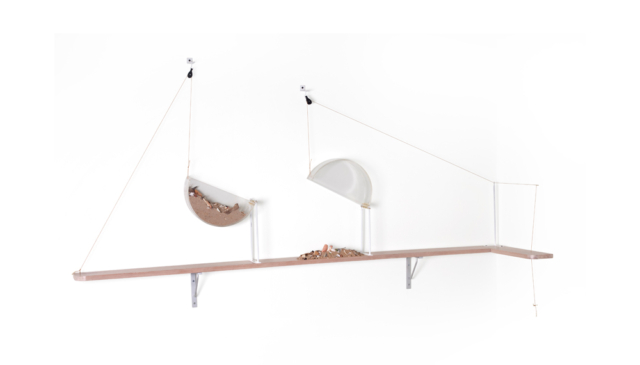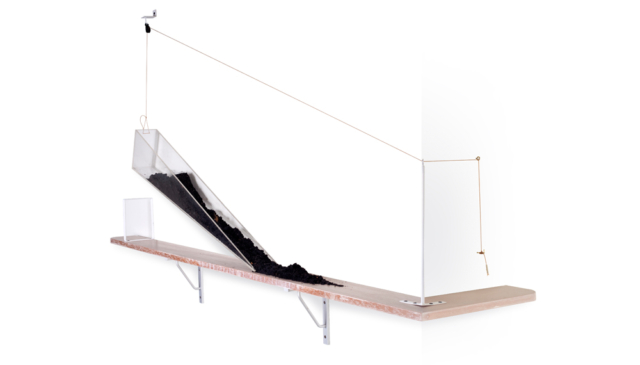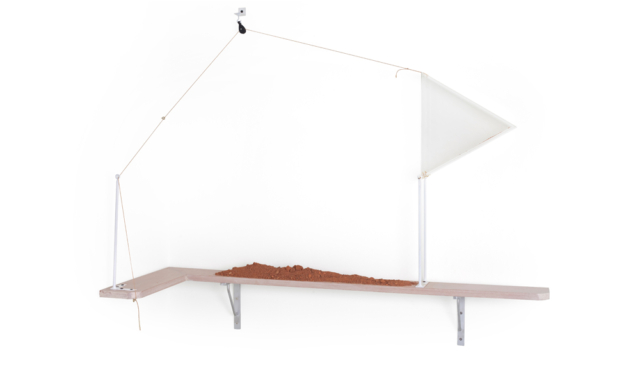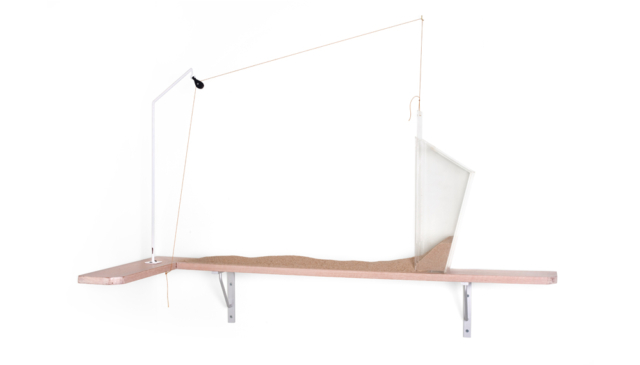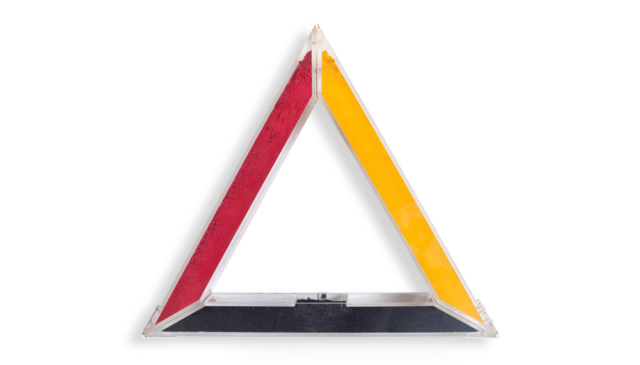Formal (and) Scapes
Project Room 2012
MO: Formal(and)scapes is the canopy title under which Dhavinder Singh presents his carefully curated series of five new works. Interactive and
intellectual, these site-specific installations result from a formalistic approach into the artist’s examinations of the visual and cerebral elements of
fine art, using landscapes as the conceptual starting point.
The landscape has traditionally been a subject artists look to when contemplating occupied spaces, be they natural or manufactured, and the
impact of humans and society on the land. Painters such as J.W. Turner grasped the subject matter and elevated it to additional heights with the
use of composition, developing new techniques to demonstrate light and luminosity. Parallels can be drawn between the process of Turner, who
trained in a strictly academic fashion before expanding into an increasingly loose style in order to create highly experimental paintings, and
Dhavinder, a talented intellectual who challenges the acceptable definition of painting. It was precisely this mix of formalistic approaches with new
ideas that marked Turner out as an artist who bridged the gap between “traditional” art and Modernism, a genre whose emergence brought new
challenges to the art world. Artists began to struggle with reconciling the depiction of real world experiences through the often two-dimensional
reality of traditional art materials. British artist Andy Goldsworthy, who concerns himself with Land Art, broke through this barrier with the use of
elements from landscapes themselves in his work. The inclusion of natural matter such as stone, twigs, flowers, leaves and icicles afford him the
ability to illustrate specific aspects of the natural world without resorting to producing impressions. A similar thread runs through MO:
Formal(and)scapes. Dhavinder’s use of sand, turmeric and saffron to obtain an undistllled colour and texture carry traces of Goldsworthy’s
influence.
MO: Formal(and)scapes is created using custom made acrylic cases, filled with organic material including saffron, turmeric and sand, wooden
shelves and hinge and pulley systems. Dhavinder’s juxtaposition of natural and artificial matter slots neatly into the current parameters of
contemporary art which looks to highlight harmonious conflicts, understanding that is a position which well defines the currency of the twenty-first
century. This mixed media approach is not entirely new for the artist; indeed previous works such as the recent Magnum Opus: Landslide cleverly
incorporate these highly current ideals of contrast and minimalism. A late 2013 work, Magnum Opus: Landslide features a large yellow triangle, with
a smaller black triangle at its tip. A pulley system is installed between the triangles as part of the work. Choosing to involve organic materials,
Dhavinder poured turmeric into the large triangle, and black sand into the smaller triangle at the tip. This period was one where the artist cemented
his experimentations with extracting pure pigmented colours in order to discover which satisfy his vision. The established thread of clean simplicity
continues through to MO: Formal(and)scapes, belying the incredible technical feat behind their inception and creation. Fabricating the cases from
acrylic requires millimetre precise technical specifications and assembly, as do the custom made clips used in mounting them on to the wall. Pure
undistllled colours from organic matter highlights the isolation of colours themselves to the viewer. It should be noted that the ability to edit and
extract specific shades from an inexhaustible palette requires an integrity of vision. As is a signature of true minimal artists, Dhavinder’s vision in
terms of colour, composition and space is uncompromising.
The use of powdered matter contributes to the surprising appearance of MO: Formal(and) scapes. In each of the works, the artist either unhinges
the acrylic cases or engages the levy system, causing the containers to pour out their contents in an irrepressible manner. A number of undefinable
forms result on and around the wooden shelves lining the base of the works, resulting in new, spontaneous forms. An interesting contrast is now
created between the hyper precise, technical vessels and the natural spillage structures. Dhavinder notes one of his aims was to arrive at a self
manifested outcome, appearing of its own volition. Subtly, and without force, he manages to trigger shadow and play with colour. He concerns
himself more with the support structure and sense of light and tonality, principles he underscores as essential fundamentals for the creation of art.
The artist seems to be redetermining the format of art, which typically exists in defined boundaries. This process gives rise to associations with
landscapes, unplanned forms of nature, forms that are still in transition and questions the line between nature and the abstract. A contradiction is
expressed in terms of the appearances between the polar opposites of the uninhibited, organic powder and the linear, austere acrylic. It is
impossible to touch the installations without disturbing the visual, raising awareness in the audience on the fleeting presence of nature in an
increasingly developed world.
While continuing aspects from previous works, MO: Formal(and)scapes shows a growth period in Dhavinder’s career. The artist is now breaking
away from his previous works, be they drawing, painting or even installation. This new series of works crosses over into art for which the concept
and execution take precedence. The use of the installations themselves to somehow create new forms can be seen as the artist’s attempt to mimic
the use of machinery in creating man made landscapes. Living in the urban landscape of Kuala Lumpur, Dhavinder observes the interminable
development of infrastructure surrounding him daily. Studying development from foundation to finish he has the desire of a contemporary artist to
depict the fabric of modern living and issues in an intellectual manner. MO: Formal(and)scapes is indeed a representation of the artist’s experiences
living in a metropolitan environment.
Built for corners in walls, Dhavinder maps out the exhibition of his installations to offer a specific, streamlined presentation. Restricting the viewers’
ability to see the whole series from any single location, Dhavinder challenges his audience to imagine the series in an entirety by piecing together
memories of the works from each vantage point. MO: Formal(and)scapes is arranged to emphasise and reveal the architecture of the space it
occupies. Sharing one common area, it is as if the installations and gallery are intertwined for the purpose of this show. Eliminating any barrier
between viewer and artwork encourages the audience to consider their personal relationship with each piece. The viewers are encouraged to
interact with each work on their own level: approaching, retreating, circling or stopping to contemplate. As such MO: Formal(and)scapes can be
seen to present a series of objects of “charged neutrality”. Directly engaging and interacting with their immediate space, the installations openly
reveal everything about themselves and they subsequently approach the viewer as a subject, establishing highly personal and two-way
relationships between the installation and the observer.
Minimal Art is an abstract genre centring on the essential and elemental features of art. Emphasising pure shapes and colours, minimalist artists
strive to decant their art into its structural origins. The result is generally purely aesthetic and provides the viewer with a strongly visual approach.
Dhavinder attempts to communicate an immediate, purely visual response, allowing his audience to experience all the more strongly the pure
qualities of colour, form, space and materials. In this way his works are de-mystified, revealing their most fundamental character. With MO:
Formal(and)scapes the medium and materials of the work are the primary reality, bolstered by a successful, innovative attempt to reinterpret the
landscape as a concept. Dhavinder has dissected the lessons of his predecessors, taking apart their themes and completely personalising them by
extracting the essence from established conventional styles. His sophisticated aesthetic approach is highly revolutionary in contemporary Malaysian
art, where minimalism is still in its infancy, leading to a keen interest in Dhavinder’s work from critics, curators and collectors.

